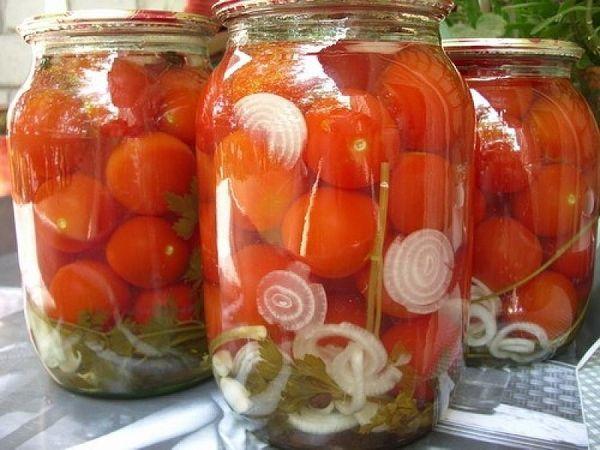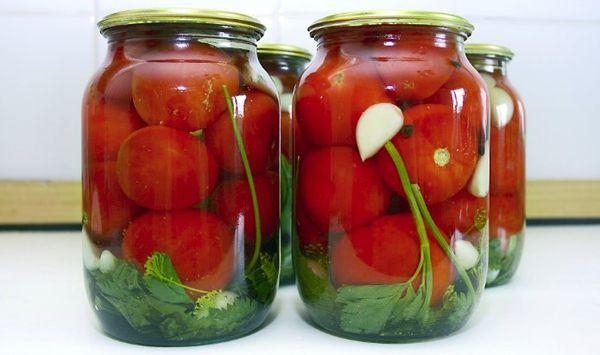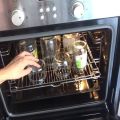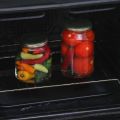What to do with swollen cans of tomatoes and how to save seals
Many inexperienced housewives very often have the question of what to do if the cans of tomatoes are swollen. In this case, you cannot make hasty decisions and immediately throw out the exploded can - with the right approach, conservation can be saved. In order to avoid such a situation, it is necessary to observe the technology of preparation of conservation, its rolling and storage.
Causes of bloating cans
The main reasons that the preserves with tomatoes are swollen are the following violations of the cooking process for this seaming:
- Getting into conservation of spoiled fruits damaged by late blight.
- Use for preservation of poorly washed and sterilized containers.
- The presence of small chips, cracks on the necks of the cans, due to which the air, which leads to its deterioration, gets into the conservation.
- The presence of dirt particles on the surface of insufficiently thoroughly washed preservation components - tomatoes, spices (dill, horseradish leaves, bay leaves, allspice).
- Failure to comply with the proportions of sugar, salt, vinegar (citric acid) used in the preparation of the marinade for pouring tomatoes.
- Insufficient temperature and duration of sterilization of filled cans.
- Poor sterilization of rolling (screw) caps.
- Insufficient tightness of cans after seaming.
How to save cans from explosion when swollen?
To protect a swollen container with tomatoes from an explosion, you should know the following:
- The sooner such a bank is discovered, the easier it is to save it. The storage place for preserves is usually equipped with racks, shelves. In such rooms, each bank is clearly visible. Their condition should be examined periodically, especially in the first weeks.
- As soon as in one of them there is a slight clouding of the brine and swelling of the lid, it is immediately placed in a cooler place for several days, for example, in a refrigerator.
On a note. A sign of an exploded conservation is the characteristic loud bang emitted by the lid that is losing its tightness.

What to do if a can of tomatoes exploded?
If the fermentation process in a can of tomatoes could not be stopped, and it exploded, then the product must be re-preserved as follows:
- The brine is drained from the can.
- The fruits removed from the container are inspected for rot and mold. If signs of deterioration are found, the can is not re-preserved, but its contents are thrown away.
- If the fruits do not show signs of spoilage, they are washed with a 5% solution of ordinary table salt.
- The brine drained from the jar is filtered through dry and clean medical gauze, poured into a container of a suitable volume and brought to a boil.
- The container, freed from conservation, is thoroughly washed with a warm aqueous solution of baking soda, rinsed under a stream of cold running water.
- The jar is sterilized in an oven of a suitable size and volume at a temperature of 120 0 From or above the neck of a boiling kettle.
- In boiling water, sterilize a new rolling or screw cap for 3 minutes.
- The prepared fruits are placed in a sterilized container and filled with hot brine.
- The jar is rolled up, turned upside down and allowed to cool to room temperature.

After cooling, the container with conservation is placed for long-term storage on the lower shelf of the refrigerator. In the cold season, it is stored in cellars or underground. The cans rolled using this technology, subject to storage conditions, no longer explode, and their contents can be safely eaten.
How to avoid the problem?
In order to avoid swelling of cans with conservation, you must adhere to such simple rules as:
- For conservation, fruits and spices not damaged by diseases and pests are harvested.
- Sealing containers are preliminarily inspected for cracks, chips.
- Preservation jars are thoroughly washed - first with warm soda solution, and then rinsed under cold running water.
- The collected fruits and spices are thoroughly washed under running cold water.
- Seaming containers are carefully sterilized over the steam of a boiling kettle or in a spacious hot oven.
- The break-in lids, as well as cans, are sterilized in boiling water for 3 minutes.
- The pickle (marinade) for pouring the tomato is prepared in accordance with the selected recipe, strictly observing the proportions of water, sugar, salt, vinegar (citric acid).
- The cans are rolled up only with a serviceable seaming key (machine).
- To check that there are no brine leaks from under the lid, each of the rolled containers is slightly tilted for a while - if the lid is not sealed, brine will ooze out from under it.
- The rolled up cans are turned over with the lid down, placed on a horizontal surface and covered with a warm blanket, a blanket. This is necessary in order to complete the sterilization of its contents inside the conservation.
- The sunsets are stored in a cool and dark place - cellar, pantry, underground.

The condition of the stored preserves is periodically checked - in the warm season, the banks are inspected once a week, from late autumn to early spring - once a month.








